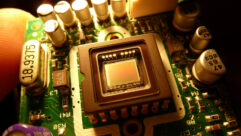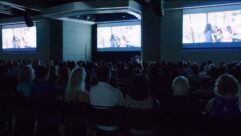VISUAL TRICKERY
Sep 1, 1998 12:00 PM,
Richard Zakia
Illusions are real in the sense that they are perceived as being real. Wedeny this reality when we insist that visual reality coincides withphysical reality. There can be, and is, a difference between what we knowand what we see. Illusions can be defined as experiences not in accord withphysical reality. When we think of illusions, we usually think of visualillusions because vision is our dominant sense. All of our senses-sound,taste, touch and smell-are subject to illusions, and our language confirmsthis. Your whistle sounds like that of a bird. This mock apple pie tasteslike the real thing. I know it’s not a silk scarf but it feels like silk.This new fragrance smells like roses. The word synesthesia defines thisphenomenon.
Fooling the eyeCreating illusionary images has a long recorded history that began inAncient Greece and extends to modern sophisticated computer imaging. Whatcame to be known as tromp l’oeil (fooling the eye) has taken many formsover the years, including some of the graffiti seen on city walls andbuildings. Tromp l’oeil dealt with a type of hyper-reality where twodimensional images took on a realistic three-dimensional appearance thatwas so convincing that one had to reach out and touch the painting toconfirm it was indeed a painting. Some contemporary resin sculptures are sorealistic that it is not unusual to see a person reach out and touch themto confirm they are not real.
There are many different types of visual illusions but most can be placedinto three broad categories-geometric, chronometric and colorimetric. Thegeometric illusions are a result of misperception of length, size shape anddirection. The chronometric illusions involve time and movement, andcolorimetric illusions testify to the fact that color is a chameleon whoseperceived hue, saturation and brightness can change with changes in thesurround, color temperature of the light source, light level and otherfactors.
Geometric IllusionsAn important aspect of human vision is that it does not see things inisolation but rather in context (relationships). What we attend to and seeat any one time is always in the context of other potential information.What we see is referred to as figure and its context is background.Perceptually, we cannot separate the two, figure from background. They areinterdependent. We see them in relation to each other, and thatrelationship determines what we see. This is the key to understanding mostillusions. By controlling the background, the length, size, shape,direction of a line and the color, an object can be changed.
Figure 1 shows examples of illusions in which the length of lines appearsto be different from their actual length. Perceptually, they are different;physically, they are not. If the surround were removed we would see them ashaving the same length. You may want to prove this by putting a piece oftracing paper over the illustrations and tracing the lines that appear tobe different lengths.
The family of illustrations in Figure 2 shows how the surround can changethe appearance of the size of a visual element. Notice that some illusionsof size are just variations of others. Again, it is the relationshipbetween figure and ground that creates the illusion.
Figure 3 shows how the angular and circular background lines can change theshape of a horizontal line, square or circle. In the Hering and Wundtillusions, horizontal lines bend and become convex or concave dependingupon how the background lines intersect the horizontal lines that are seenas figure. The same is true for the Ehrenstein, Orbison and Ponzoillusions, all of which are all variations of the Hering-Wundt illusion.
How the surround can change the direction of a line is seen in Figure 4. Inthe Zollner illusion, the angle at which the short lines intersect thelonger lines causes the longer lines to be seen as tilting in oppositedirections. Figure cannot be separated from ground.
A number of geometric illusions are related in that the lines crossing orintersecting one another can appear to bend and change shape. With theZollner illusion, the lines appear bent away from one another rather thanparallel. The Hering and Wundt illusions exhibit similar characteristics.
Dr. Rudolf Arnheim gives an explanation of the bending of lines in theHering Illusion based on the principle of tension reduction (See Figure 5).In looking at something we tend to see it in such a way that it will causethe least amount of visual tension. “An objectively straight line crossinga sunburst of radii bends toward the center. In this case, the centric,expanding pattern creates an inhomogeneous field in which objectivestraightness is no longer as devoid of tension as it would be in ahomogeneous field B. Its equivalent in the centric field would be acircular line C because all sections of such a line would be in the samerelation to the field and to its center. The straight line in A, on theother hand, changes angle, size and distance from the center in each of itssections. To the extent that the line gives in to the tendency towardtension-reduction, we see it curving [ref. 1].”
Reversible illusionsThere is a class of illusions that could be called reversible images orflip-flops. An article titled “Multistability in Perception” by FredAttneave describes a number of these, including the familiar Necker cube,and works by artists Salvator Dali and Maurits Escher [ref. 2]. In Figure6, all four reversible figures are related in that their geometry issimilar, and they are based on the initial configurations of Ernst Mach andLouis Necker.
Time (movement) illusionsImagine two small lights a short distance apart in a darkened room (SeeFigure 7a). Number 1 light is flashed briefly, then goes off, and for afraction of a second, nothing is visible. Now number 2 light is flashedbriefly, then goes off, and for a brief interval nothing is visible. Theprocess continues with the lights going on and off. If the interval (darktime) between the light going on and off is right, the observer will see anapparent movement from 1 to 2. This illusion of movement by two stationarylights is so convincing that it cannot be distinguished from the realmovement. It has been referred to as the Phi phenomenon or stroboscopicmovement.
Without such a phenomenon, motion pictures, which are still picturesprojected at a rate of 24 frames per second, would not be possible (SeeFigure 7b). A movie frame is projected at 1/48 of a second followed by adark period of 1/48 of a second (total time of 1/24 of a second per frame),and then the next frame is projected and so on. The result is theperception of a moving image. Movement on a video screen, which is made upof thousands of red, green and blue phosphors (little colored lights) thatgo on and off, depends upon the same phenomenon. A series of alternatinghorizontal lines of phosphors is scanned and light up every 1/60 of asecond for a total time of 1/30 of a second per still image on the screen.
Computer graphics and animationComputer graphics, computer animation and multimedia lend themselves nicelyto creating an illusion of three dimensions on a video screen. What addsgreatly to the illusion of depth with moving images is the visualexperience of movement. As objects increase and decrease in size, theyappear to move forward and backward. They can move to the right and to theleft, up and down, yaw, pitch and roll-movement in every possibledirection. Colors add to the illusion-warm colors moving forward and coldcolors receding. Sound can enhance the illusion of 3D by increasing anddecreasing in volume in the type of sound and also the direction it seemsto come from relative to the moving image on the screen.
Pulfrich illusionIf one were to look at a simple pendulum movement A in Figure 8 with a darkfilter or sun glass covering one eye, an elliptical movement would be seenB, rather than a linear movement. The filter causes a delay in the signalsreaching the brain from the retina. “Since the target is moving, a temporaldelay corresponds to a spatial displacement: the covered eye is seeing thetarget with a delay in time, and thus at a spatially lagging point in itstrajectory. The lag produces a stereoscopic disparity, and therefore ashift in depth {ref. 3].”
The Pulfrich illusion applies not only to a linear pendulum movement, butalso to any object in a horizontal movement relative to the eyes. “In anordinary television picture, for example, objects moving from left to rightwill appear displaced in front of the screen if the right eye is covered bya filter [ref. 4]” Some years back, an experimental video advertisement,based on the Pulfrich illusion, successfully presented a 3D appearance on avideo screen for those who watched the television commercial with filteredviewers that had been made available.
Shrinking size, increasing distance illusionA dramatic demonstration of the relationship between size and distancerequires only a white balloon and a darkened vacant stage or area (SeeFigure 9). With a spotlight on the inflated balloon, it is slowly deflated.As it becomes smaller and smaller it appears to be moving farther andfurther away, distancing itself from the viewer. In fact, the balloon hasnot moved at all, only gotten progressively smaller in size. Sizedetermines distance and distance determines size. The two are inseparable.A video monitor and computer can be used to create the same illusion. As awhite circular area with a dark surround on the screen is made to graduallybecome smaller, it will appear to be distancing itself.
Waterfall illusionIf one were to stare at a waterfall for a minute or so and then look away,the aftereffect would be a movement of the waterfall image in an oppositedirection-up instead of down. A similar illusion occurs when looking at arotating spiral; the aftereffect is an image of the spiral rotating in anopposite direction. It seems that our perceptual system, like ourbiological system, tries to restore a balance and maintain equilibrium byresponding in an opposite way. With color, for example, looking a redcircle for a period of time and then away from it results in a cyanafterimage.
Size-size illusionBecause perception is relative, the size of an object is judged on thebasis of context, its relationship to other objects and to some extent,familiarity. A classic example of this is the painting, “The ListeningRoom” by Rene Magritte. An apple squeezed into a room appears to be thesize of an elephant. By assuming the room is normal size, there is noalternative but to see the apple as huge. A question to be raised here,however, is why isn’t the room seen as miniature and the apple as normal?The same illusion occurs when normal size people are photographed or filmedin miniature settings, we see the people as giants and not the furniture asminiature.
Emmert’s illusionIf a person sits next to a slide projector as a slide is first projectedonto a screen at a distance of about 10 feet (3 m) and then onto a screenat a distance of 20 feet (6 m), the person will see the second image asbeing larger even though the angles of the projected image (at theprojector) and the received image (at the eye) along with the size of theimages formed on the retinas are all identical for the two images.
One can experience the same effect when an afterimage is visually projectedonto surfaces at different distance from the viewer; the apparent size ofthe afterimage increases with the distance of the surface. The relationshipbetween the apparent size of a projected afterimage and the distance of theprojection surface is know as Emmert’s Law.
Color illusionSimultaneous contrast and assimilation are two of the most prominent colorillusions as shown in Figure 11. The bluish patches that stand out asfigures are all the same color in terms of a physical measurement. Theywould all have the same color density. The different backgrounds, however,change their perceived color. Color as seen is different from color asmeasured. Perceived color is relative and dependent upon its surround,whereas color as measured by an instrument such as a colorimeter isindependent of it surround. This should raise a caution flag when isselecting a color from a published array of colors, such as the colorpalette seen on video screens or in print form.
Notice in Figure 11 that with simultaneous contrast, a dark backgroundmakes the color blue look lighter; a light background makes it appeardarker. The opposite is true with the assimilated black lines and whitelines in the lower part of the illustration. Dark lines, as background,make the blue appear darker, and the light lines as background make theblue appear lighter. In one case, the background is assimilated, and in theother, it is not; it is contrasted simultaneously. In a situation wherefigure is a neutral color having no hue and the background a saturatedcolor with, for example a reddish hue, the neutral color would lose itsneutrality and take on the complementary cyanish color. This is how the eyeand mind perceives. It is an illusion only if we insist on a physicalreality being the only reality.
Artists have always know about color illusion as have scientists. EugeneDelacroix said, “Give me mud and I will make the skin of Venus out if it,if you will allow me to surround it as I please.” Dr, Edwin Land stated, “Acolor cannot exist without an environment; environment makes the color.”
That the color of an object is highly dependent on its surround can be usedto advantage to overcome some of the physical limitation in colorreproduction. Regardless of the medium ( photography, printing, xerographyor video), none will faithfully reproduce all colors. For example, a videoscreen is not capable of reproducing an aquamarine color correctly. Theproblem is not in the recording of the color but rather in the display on avideo screen.
One way to overcome the problem is to change the surround. A red surroundcan change the color of the aquamarine (simultaneous contrast) and make itappear more correctly. A similar problem exists with other precise colorsto be faithfully reproduced on a video screen such as IBM blue, Coca Colared and Kodak yellow.
Illusions are experiences we have that do not agree with our physicalreality. Can the same be said for physical realities that do not coincidewith our visual experience? In any case, without these so called illusions,much of what we see in art and in movies would not exist, nor would some ofthe contrived experiences in theme parks or virtual reality. Simulatedtraining arrangement for our space program and other programs would beunheard of without our ability to create and experience illusions.
1. Rudolf Arnheim, Art and Visual Perception, Berkeley, CA: University ofCalifornia Press, 1974, p.420.
2. Fred Attneave, “Multistability in Perception,” Scientific American,December 1971.
3. Richard Gregory, The Oxford Companion to the Mind, New York: OxfordUniversity Press, 1991, p. 663.
4. Ibid., p. 663.









